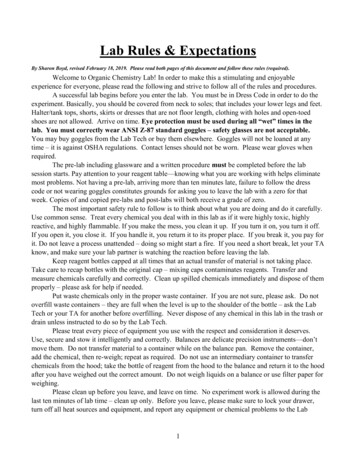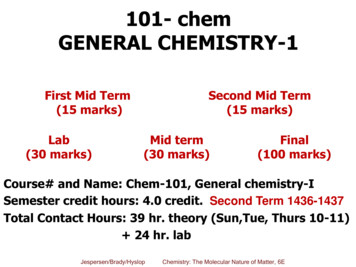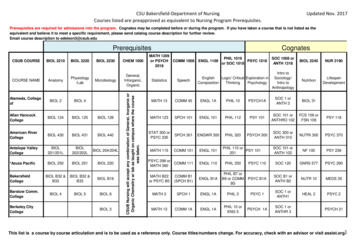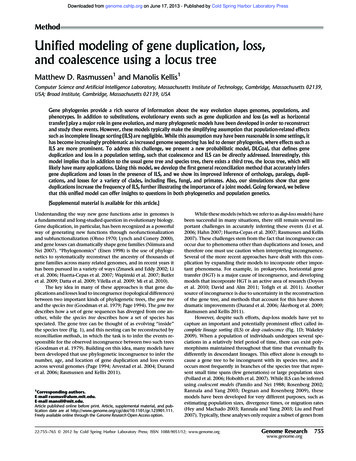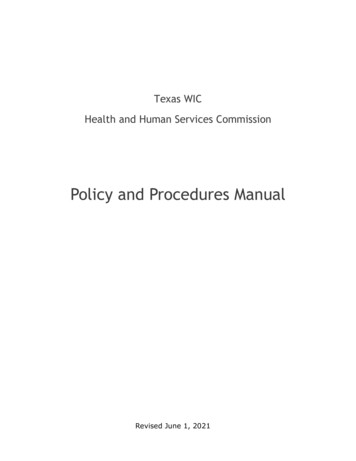
Transcription
Chem Soc RevREVIEW ARTICLEHydrogel bioelectronicsCite this: Chem. Soc. Rev., 2019,48, 1642Hyunwoo Yuk,†a Baoyang Lu†ab and Xuanhe Zhao*acBioelectronic interfacing with the human body including electrical stimulation and recording of neuralactivities is the basis of the rapidly growing field of neural science and engineering, diagnostics, therapy,and wearable and implantable devices. Owing to intrinsic dissimilarities between soft, wet, and livingbiological tissues and rigid, dry, and synthetic electronic systems, the development of more compatible,effective, and stable interfaces between these two different realms has been one of the most dauntingchallenges in science and technology. Recently, hydrogels have emerged as a promising materialcandidate for the next-generation bioelectronic interfaces, due to their similarities to biological tissuesand versatility in electrical, mechanical, and biofunctional engineering. In this review, we discuss (i) thefundamental mechanisms of tissue–electrode interactions, (ii) hydrogels’ unique advantages in bioelectricalReceived 24th July 2018interfacing with the human body, (iii) the recent progress in hydrogel developments for bioelectronics, andDOI: 10.1039/c8cs00595h(iv) rational guidelines for the design of future hydrogel bioelectronics. Advances in hydrogel bioelectronicswill usher unprecedented opportunities toward ever-close integration of biology and electronics, potentiallyrsc.li/chem-soc-revblurring the boundary between humans and machines.aDepartment of Mechanical Engineering, Massachusetts Institute of Technology,Cambridge, MA, 02139, USA. E-mail: zhaox@mit.edubSchool of Pharmacy, Jiangxi Science and Technology Normal University,Nanchang, 330013, ChinacDepartment of Civil and Environmental Engineering, Massachusetts Institute ofTechnology, Cambridge, MA, 02139, USA† These authors contributed equally to this work.muscular movements to complex intelligence such as memoryand reasoning. Since the discovery of bioelectricity by LuigiGalvani’s landmark experiment, a better understanding of electroniccommunications between biology and electronics, so-called bioelectronic interfacing or bioelectronics, has been one of thegrand but ongoing challenges in science and technology. Themajority of existing and emerging bioelectronic interfacesinvolve various forms of electrodes interacting with biologicaltissues.1,2 Electrodes with ever-refined performances and controlhave been available in a wide range of form factors and sizes, greatlyaided by innovations and advances in modern electronics.2–4Hyunwoo Yuk is currently a PhDstudent in Mechanical Engineeringat Massachusetts Institute ofTechnology. He received his MSfrom Massachusetts Institute ofTechnology in 2016 and BS fromKorea Advanced Institute ofScience and Technology in 2014,both in Mechanical Engineering.His research focuses on the broadtopics of mechanics and materialsscience and engineering in human–machine interfaces including robustHyunwoo Yukadhesion of soft materials, hydrogelbioelectronics, and 3D printing of advanced soft materials. He is arecipient of the Materials Research Society Graduate Student Award.Baoyang Lu is an associateprofessor at Jiangxi Science andTechnology Normal Universityin China. He received hisPhD in Materials Science andEngineering from ShandongUniversity in 2015. He has beenworking as a postdoctoral fellowin Mechanical Engineering atMassachusetts Institute of Technology since 2016. Dr Lu’s currentresearch interests include thedesign and synthesis of novelBaoyang Luconjugated polymer-based molecular systems, and fabrication and characterization of organicoptoelectronic devices.1 IntroductionElectronic activities in nervous systems are the principal constituents of our daily lives, ranging from routine regulation of1642 Chem. Soc. Rev., 2019, 48, 1642--1667This journal is The Royal Society of Chemistry 2019
Review ArticleBased on these electrodes, numerous wearable and implantableelectronic devices have recently emerged to collect and delivervarious bioelectronic signals in different parts of the human bodyas diverse as skin,5,6 brain,7 spinal cord,8 and heart.9 Particularly,various wearable epidermal bioelectronic devices have been commercialized and routinely used for diverse clinical purposes.10Miniaturized implantable devices have driven breakthroughs intreatments for neurological disorders and damage includingdeep brain stimulation probes for Parkinson’s disease11–13 andessential tremors,14 neural interfaces for robotic prostheses,15–18flexible electrode arrays for heart failures,9,19,20 and closed-loopelectrode arrays for spinal cord injuries.21,22Despite remarkable advances in the recent few decades, theintrinsic differences between biological tissues and man-madeelectronics pose immense challenges in materials, design, andmanufacturing of the next generation bioelectronics. For instance,the human body consists of a broad range of soft and high watercontaining tissues and organs. In contrast, almost all of commercially available and the majority of lab-level bioelectronic devicesrely on rigid and dry electronic components such as silicon andmetals.23–26 These stark disparities between the two realms haveintroduced significant difficulties towards seamless interfacingbetween biology and electronics.27–30The central and peripheral nervous systems ceaselesslygenerate and receive electrical and biochemical signals throughcomplex networks of neuronal cells. Unlike conventional electronics in which electrons serve as carriers of information,bioelectronic activities in the biological systems are essentiallyionic through electrolytic media.10,31–33 Ever-evolving microenvironments due to diffusive and convective exchange ofmobile ionic and biochemical species in water-rich tissuesfurther highlight the distinctive nature of the biological systemsover electronic systems. Together with mechanical and compositional dissimilarities, these inherent mismatches betweenXuanhe Zhao is an associateprofessor in Mechanical Engineering at Massachusetts Instituteof Technology and the founder ofSoft Active Materials Laboratory(http://zhao.mit.edu/). His researchgroup is advancing the science andtechnology to seamlessly interfaceand merge humans and machines,particularly through inventing softmaterials and machines. Dr Zhaois the recipient of the early careeraward or young investigator awardXuanhe Zhaofrom National Science Foundation,Office of Naval Research, Society of Engineering Science, AdhesionSociety, and American Vacuum Society. He held the Hunt FacultyScholar at Duke and d’Arbeloff Career Development Chair and RobertN. Noyce Career Development Professor at Massachusetts Institute ofTechnology.This journal is The Royal Society of Chemistry 2019Chem Soc Revbiology and electronics signify the high hurdles to bring thetwo realms closer.Hydrogels, crosslinked polymer networks infiltrated withwater, have been extensively studied in tissue engineeringand biomedicine due to their resemblance to biological tissues(Fig. 1).34,35 The soft and flexible nature of hydrogels allowsminimization of mechanical mismatch with biological tissues,and the high water contents of hydrogels provide wet andion-rich physiological environments. Moreover, the remarkableflexibility in the design of their electrical, mechanical, and biological properties renders hydrogels a unique bridging materialto biological world.36 Powered by these exceptional advantages,hydrogels have recently attracted growing attention in bioelectronics, as part of continued endeavor toward seamlessinterfacing between biology and electronics.While a growing volume of bioelectronic devices and applications have adopted hydrogels to achieve improved interfacingwith the human body, many of such approaches are still limitedin an Edisonian manner. Simple additive combination of hydrogels in existing devices often results in non-optimal performanceand a significant increase in the burden of development processes. Future innovations in hydrogel bioelectronics require usto harness hydrogels’ unique advantages based on the fundamental understanding of tissue–electrode interactions, in orderto rationally guide the engineering of various properties anddesign parameters. Along with fundamental understanding,advances in hydrogel bioelectronics progress hand-in-hand withbreakthroughs in material developments, synergistically benefiting each other.This review is aimed to provide a set of rational guidelinesfor the design of future hydrogels in bioelectronic applicationsbased on understanding the fundamental mechanisms of bioelectronic communications between biological and electronicsystems. We start with a brief overview on the fundamentalmechanisms of tissue–electrode interactions to provide a rationalfoundation that justifies hydrogels’ unique benefits to bioelectronics. Thereafter, the recent advances in hydrogel bioelectronics are categorized into four classes: (i) hydrogel coatingsand encapsulations, (ii) ionically conductive hydrogels, (iii) conductive nanocomposite hydrogels, and (iv) conducting polymerhydrogels, followed by discussions on important issues inFig. 1 Hydrogels at the interface between biology and electronics.Hydrogels possess a unique set of properties to bridge the gap betweenbiology and electronics, providing promising opportunities for bioelectronicsapplications.Chem. Soc. Rev., 2019, 48, 1642--1667 1643
Chem Soc Revhydrogel-device interfaces. Last but not least, we propose anumber of directions and guidelines for the design of nextgeneration hydrogel bioelectronic materials and devices, andconclude with a perspective discussion on the remaining opportunities and challenges. By highlighting hydrogels’ importancein bioelectronics spanning from tissue–electrode interactions toadvances in materials, we hope to bring new insights intoseamless merging between biology and electronics.2 Tissue–electrode interfacesBiological tissues are typically considered as volume conductors with a moderate level of conductivity (e.g., electricalconductivity s 0.1 to 1 S m 1) in electrical models, owing tomobile ionic species dissolved in the media.10,31,37,38 As electrons cannot serve as charge carriers in electrolytic tissuemedia, electrical communications between neuronal cells mostlyrely on ionic fluxes.1,39,40 To establish electrical communicationsbetween neural tissues and external electronics, electrodes havebeen the most commonly used terminals, through whichsignals and information can transmit from cells to electronicsand vice versa. However, unlike biological tissues, almost allconventional electronic systems depend on electronically conductive materials such as metals, in which free electrons act asmobile charge carriers.1,26,33,41,42 This characteristic differenceintroduces a unique interface between tissue and electrode, atwhich ionically and electronically carried signals are exchangedwith each other.Bioelectronic activities in tissue–electrode interfacesinvolve various ionic and electronic interactions across a widerange of length scales (Fig. 2A). Starting from the tissue side ofthe picture, spikes of ionic currents or action potentials (APs)in excitable cell membranes provide the most basic element ofbioelectronic activities at the nm length scale.33,39,43 Thetransmembrane potential of an individual neuronal cell maintains a negative value (B 60 to 75 mV) in the resting statedue to the imbalance of ions (typically an excess of intracellular K and extracellular Na ). The transmembranepotential fluctuates from the resting potential by excitatory(depolarization to more positive potential) or inhibitory(hyperpolarization to more negative potential) inputs fromother neurons or electrodes.10,39 When the net excitatory inputsprovide enough depolarization beyond the threshold (mostly 50to 55 mV), voltage-gated Na channels open allowing a rapidinflux of Na ions into the cells, which generates a spike ofdepolarization. Upon reaching a potential around 30 to 40 mV,the transmembrane potential repolarizes to the resting potentialvia slow efflux of K ions.39 These processes create impulsive localionic currents and potentials (or action potentials) across thecellular membrane as well as the surrounding extracellular space(Table 1).Extracellular potentials decay rapidly away from the source(e.g., soma or axon of neurons) at cellular length scales (e.g.,10 to 100 mm).10,33 Superposition of all concurrent activities ofneurons generates tissue-scale (e.g., mm to cm) oscillations and1644 Chem. Soc. Rev., 2019, 48, 1642--1667Review Articlerhythms of electrical potentials, which are called local fieldpotentials10,31,38,44 (Fig. 2A). Overall, the tissue side of bioelectronic activities relies on spatial and temporal changes ofionic fluxes across different length scales.Moving toward the electrode side, interactions betweenneural tissues and electrodes are less specific in a larger distance(e.g., mm to cm). Local field potentials convey information fromcollective activities of numerous cells and the contribution froman individual neuron is mostly indistinguishable.10,41,45 Closerto a cellular distance (e.g., o100 mm), extracellular potentialsfrom each neuron present without significant decay, and theelectrodes begin to be able to sense or actuate individualneuron.33,43 At an even smaller length scale (e.g., 1 to 100 nm),ionic tissue media and electrodes form an electrolyte–electrodeinterface at which exchange between ionic and electronic signalstakes place (Fig. 2B).Electrodes communicate with biological tissues in a bidirectional manner. In one way, electrodes stimulate excitable cells(e.g., neurons) by delivering electrical inputs toward the tissues.In another way, electrical signals from electrically active cellspropagate toward and are recorded by the electrodes. Duringthis bidirectional communication, electrical signals are transmitted via ionic currents and electric potentials in the electrolytic tissue media and electronic currents and electric potentialsin the conducting electrodes.1,32,45,46 In addition, the potentialdifference at the electrolyte–electrode interface is equilibratedby the electron flow in the electrodes, ion flow in the tissuemedia, and possible reactions of the electrolyte and electrodes.42Therefore, in stimulation applications, the applied potential onthe electrode drives ionic current injected toward the tissue mediaand generates the corresponding electric potential on the outermembrane of the targeted neurons, by which the neurons arestimulated31,39,47,48 (Fig. 3). Conversely, in recording applications,the ionic flux by action potentials of neurons drives electron flowsin the electrode by building up the electrolyte–electrode potentialdifference (Fig. 4).The tissue–electrode interfaces are often depicted by usingthe equivalent circuit models in order to more quantitativelydiscuss complex bioelectronic phenomena. Fig. 2C and D showthe simplest equivalent circuit models for bioelectronic stimulation and recording, respectively. The Vsti and Vrec are theelectric potentials of the external electronics, which serve as aninput for stimulation applications (e.g., stimulation waveforms)and an output for recording applications (e.g., neural activityrecordings), respectively.41 The electrolyte–electrode interfaceis depicted as a parallel circuit of the leakage resistance Re andthe electrical double layer (EDL) capacitance Ce in the simplestform.1,41,43,49 The interconnect resistance Ric captures theresistance of the higher order electronic circuitry connectedto the electrode. In stimulation applications, electrical signalsflow from the electrode toward the tissues and generate theelectric potential Ve in electrolytic media and applied on theouter membrane of the targeted neurons (Fig. 2C). On the otherhand, in recording applications, electrical signals are originatedby the bioelectronic activities of neural cells (i.e., ionic currentsby action potentials, IAP) and generate the electric potential Ve inThis journal is The Royal Society of Chemistry 2019
Review ArticleChem Soc RevFig. 2 Schematic overview of tissue–electrode interfaces. (A) On the tissue side, the transmembrane potential comprises the most basic bioelectronicactivity at the nm scale. Distribution of ionic species in the extracellular media and cytosol generates the transmembrane potential which is tightlyregulated by ion channels. At the mm scale, electrically active neural cells generate an extracellular potential. The red and blue contours correspond toequipotential lines for positive and negative values for local field potential amplitude, respectively. At the larger scale, collective activities of electricallyactive neuronal cells generate a local field potential which is represented as black lines. (B) Toward the electrode side, bioelectronic devices are typicallyintroduced within 100 mm of target cells, and the exchange between ionic signals in biological systems and electronic signals in electronic systemshappens at the electrolyte–electrode interface at the nm scale. (C) Equivalent circuit model of tissue–electrode interfaces for bioelectronic stimulation.Vsti represents the input for bioelectronic stimulation with the interconnect resistance Ric. Ve represents the electric potential within electrolytic mediagenerated by Vsti applied on the outer membrane of the targeted neurons. (D) Equivalent circuit model of tissue–electrode interfaces for bioelectronicrecording. At the interface between biology and electronics, the electrolyte–electrode interface is considered as a parallel circuit of the EDL capacitance,Ce, and the leakage resistance, Re. Vrec represents the output for bioelectronic recording with the interconnect resistance Ric. Ve represents the electricpotential within electrolytic media generated by bioelectronic activities of neurons (i.e., ionic currents by action potentials, IAP) applied on the electrodesurface. For both bioelectronic stimulation and recording, the electrolyte–electrode interface is considered as a parallel circuit of the EDL capacitance,Ce, and the leakage resistance, Re.electrolytic media and applied on the electrode surface (Fig. 2D).In addition to the electrical interactions (e.g., stimulations andrecordings), there also exist biomechanical interactionsbetween the tissues and electrodes. In the following sections,we discuss various tissue–electrode interactions in hydrogelbioelectronics (Table 2).2.1Bioelectronic stimulationBioelectronic stimulation finds critical importance as a versatile tool for a wide range of neuroscientific studies and clinicaltreatments.11,12,16,22,50 Electrical stimulation of the biologicalsystems can largely be divided into two major categoriesbased on the invasiveness of tissue–electrode interactions:invasive and non-invasive stimulations. Implanted stimulationThis journal is The Royal Society of Chemistry 2019electrodes provide more invasive but direct interfacing with thetissues. Implanted electrodes in the proximity of target neuronshave been adopted in sensory stimulations (e.g., cochlearimplants and retinal implants),51–53 neuromuscular stimulations (e.g., control of limbs for rehabilitation), and treatmentsfor neurodegenerative disorders (e.g., deep brain stimulationsfor Parkinson’s disease).54 Epidermal stimulation electrodesoffer non-invasive but less specific interfacing with the tissues.One classical example of epidermal bioelectronic stimulation istranscutaneous electrical nerve stimulation (TENS), which hasbeen widely adopted in clinical settings for pain relief.55–58Despite the broadness in forms and applications, all electrodebased bioelectronic stimulations share common physicalprinciples.Chem. Soc. Rev., 2019, 48, 1642--1667 1645
Chem Soc RevTable 1Review ArticleList of definitions of terminologies used in this ume conductorOhmicInduced firings of excitable neural cells by electrical inputs from the external electronic terminalElectric potential readings by the external electronic terminal generated by neural activitiesThree-dimensional conductor with isotropic and homogeneous electrical propertyElectrical current flow in a purely resistive manner. The extracellular medium is primarily Ohmic in the 1–10 000 kHzfrequency rangeElectric potential between the extracellular space and the intracellular space in neural cellsTransmembranepotentialLocal field potentialAction potential (AP)Electrochemical reactionElectrical double layer(EDL)Current source densityCharge injectioncapacitySignal-to-noise ratio(SNR)Electric potential generated by the summed ionic currents from multiple nearby neurons within a small volume ofneural tissueImpulsive change of electric potential along the membrane of excitable neuronal cellsChemical reactions at the electrolyte–electrode interface by the applied electric potentialAccumulation of charged ions around the surface of the electrode within the electrolytic medium under the appliedpotentialRate of current flow in a given direction through the unit surface areaAmount of charge that the electrode can inject per unit area without causing irreversible electrochemical reactions ortissue damageRatio between the amplitude of recorded signal and the noise from the recordingFig. 3 Schematic overview of bioelectronic stimulation. (A) Stimulation of excitable cells is conducted via charge injection from the electrode towardthe neural tissues to depolarize the cellular membrane of the targeted neurons, which results in firing of action potentials. (B) Faradaic charge injectionmechanism relies on surface-confined electrochemical reactions of the electrode. (C) Capacitive charge injection mechanism relies on charging/discharging of the electric double layer (EDL) by accumulation of ions on the electrode without electrochemical reactions.Fig. 4 Schematic overview of bioelectronic recording. Upon firing of APs,electrically active neurons inject charges into extracellular media with thecorresponding extracellular potential and local field potential. The resultantpotential Ve within electrolytic tissue media applied on the electrolyte–electrode interface is transmitted via electronic interconnects and recordedas the output signal, Vrec.Electrodes can stimulate neurons by injecting ionic currents inelectrolytic tissue media and generating electric potential on theouter membrane of the targeted neurons. While bioelectronicstimulation has a broad range of applications from targetedstimulation of neurons around the implanted electrodes to less1646 Chem. Soc. Rev., 2019, 48, 1642--1667specific stimulation via large area epidermal electrodes, all electrical stimulations rely on triggered firing of APs by the membranedepolarization of excitable cells.39,59 Depolarization of the transmembrane potential is induced by the local field potential Veapplied on the outer membrane of the targeted neuron (Fig. 3A).In principle, Ve at a certain spatial point within the neural tissue isdetermined by electric fields in the surrounding electrolyticmedia.10,48,60 Since the physical origin of the volume-conductingelectric field is ionic potentials, Ve correlates with the ionic currentsource density J (unit in A m 2) at a point of stimulating electrodeby Maxwell’s equations of electromagnetism.10,31,32 Under standardelectro-quasi-static conditions (i.e., the magnetic contributions areneglected), Maxwell’s equations provide the simplified relationshipbetween Ve and J as J r(sVe), where s is the conductivity of thetissue media (units in S m 1).38 For the simplest case of homogeneous and isotropic Ohmic volume conducting media (i.e., ioniccurrent flows in a purely resistive manner),41,43 Ve is dictated byLaplace’s equation, r2Ve 0. Solving this equation for a singlepoint current source yields the governing equation for Ve asVe ¼Iin4psr(1)This journal is The Royal Society of Chemistry 2019
Review ArticleTable 2Chem Soc RevList of parameters for tissue–electrode interfacesParameterDefinitionVstiVrecRicCeReVe (stimulation)Ve (recording)srIinIAPIetEDLElectric potential of the external electronics as an input for bioelectronic stimulationElectric potential of the external electronics as an output for bioelectronic recordingInterconnect resistance for higher order electronic circuitry connected to the electrodeCapacitance of the electrode that charges/discharges by capacitive charge injectionLeakage resistance of the electrodeElectric potential within electrolytic media generated by Vsti on the outer membrane of the targeted neuronsElectric potential within electrolytic media generated by IAP at the electrolyte–electrode interfaceConductivity of extracellular mediaDistance between the target cells and the electrode surfaceIonic current injected by the stimulation electrode toward the tissuesIonic current injected by action potentials (APs) toward the recording electrodeElectronic current flow induced by Ve toward the recording electrode in bioelectronic recordingCharacteristic time for the EDL capacitor charging at the electrolyte–electrode interfacewhere r is the distance from the point source (units in m) and Iinis the ionic current injected at the point source (i.e., electrolyte–electrode interface) towards the tissue induced by the electrode(units in A).10,31,38 When Ve applied on the outer membraneof the targeted neuron is large enough to depolarize themembrane to the depolarization threshold (B 55 mV), stimulation of the neuron occurs by firing of action potentials(APs).39 Multiple current sources in the electrodes can beaccounted via linear summation by the superposition principlePas Ve Iin,n(4psrn) 1.41As Ve is proportional to Iin in eqn (1), the key criterion inbioelectronic stimulation is the ability to inject more ioniccurrent at the electrolyte–electrode interface without inducingadverse outcomes such as electrode degradation, water hydrolysis, and tissue damage.1,43 Two major mechanisms are widelyadopted to introduce the ionic current injected at the electrolyte–electrode interfaces: (i) faradaic charge injection based onsurface-confined electrochemical reactions (i.e., oxidation andreduction) and (ii) capacitive charge injection based on charging/discharging of the electrolyte–electrode interface1,33,42,61(Fig. 3B and C). Since the faradaic mechanism inevitablyinvolves oxidation and reduction of the electrode to allow directelectron transfer across the electrolyte–electrode interface,the capacitive mechanism is generally more desired in bioelectronic stimulations.1 For more detailed discussion onvarious charge injection mechanisms and their characteristics,the readers are guided to several comprehensive reviews in theliterature.1,33,42Capacitive charge injection can rely on either areal capacitance (i.e., EDL formation on the surface of the electrode) orvolumetric capacitance (i.e., EDL formation within the micro/nano structure of the electrode) depending on the electrodematerial.62–64 When Vsti builds up a potential difference at theelectrolyte–electrode interface, surface aggregation of oppositely charged ions rapidly forms a compact layer (or Sternlayer) with the corresponding potential drop. The residualpotential difference further creates a diffusive layer of ions (orGouy–Chapman layer) over a short distance (typically a few nm),beyond which the potential difference is equilibrated to thebulk electrolyte media65 (Fig. 3C). Essentially, the formation ofEDL is analogous to the charging of a capacitor with the samecapacitance Ce as in the equivalent circuit model (Fig. 2C).This journal is The Royal Society of Chemistry 2019The electrodes can inject ionic currents Iin until the EDL is fullycharged with the characteristic time astEDL ReCe(2)which provides an additional operational limit for stimulationinputs. Once the EDL fully forms on the electrode surface,the stimulation inputs from the electrode cannot be deliveredto neural tissues anymore as the electrode is shielded by theEDL.60,66Following the simplest equivalent circuit model in Fig. 2C,we can further express the governing equation for Iin as" # 1 11Iin ¼þ sCeþRicVsti(3)Rewhere s is the complex frequency of the stimulation waveforms.26 Combining eqn (1) and (3), the governing equationthat relates Ve and Vsti in bioelectronic stimulations can beexpressed as" # 1 111Ve ¼þ sCeþRicVsti(4)4psr ReFrom eqn (4), the amplitude of Ve is proportional to Ce and Vstiand inversely proportional to Re, Ric, and r. Hence, the highefficiency (i.e., high Ve) in bioelectronic stimulation requires aset of desired electrode features including high Ce and Vsti as wellas low Re, Ric, and r. Furthermore, high Ce for the given Re giveshigher tEDL by eqn (2), which also benefits the bioelectronicstimulation performance by widening the applicable stimulationduration.60,66 However, the electrochemical threshold, Vreac, ofthe electrode, above which adverse electrochemical reactions canoccur at the electrolyte–electrode interface during the capacitivecharge injection, imposes an upper limit to Vsti (i.e., Vsti o Vreac).Please refer to Table 3 for a summary of the requirements fortissue–electrode interfaces for efficient bioelectronic stimulationand the desired features for the electrodes.2.2Bioelectronic recordingIn addition to bioelectronic stimulation, the ability to record neuralactivities constitutes an essential component for bidirectionalcommunication between biology and electronics.1,41,43 Similarto stimulation, recording of bioelectronic signals is generallyChem. Soc. Rev., 2019, 48, 1642--1667 1647
Chem Soc RevReview ArticleTable 3 Requirements for tissue–electrode interfaces and desired electrode featuresTissue–electrode interaction RequirementsBioelectronic stimulationBioelectronic recordingDesired electrode featuresLow ReHigh CeLow RicHigh Vsti (Vsti o Vreac)Low rLow mismatch Lo
E-mail: zhaox@mit.edu b School of Pharmacy, Jiangxi Science and Technology Normal University, Nanchang, 330013, China c Department of Civil and Environmental Engineering, Massachusetts Institute of Technology, Cambridge, MA, 02139, USA Hyunwoo Yuk Hyunwoo Yuk is currently a PhD student in



